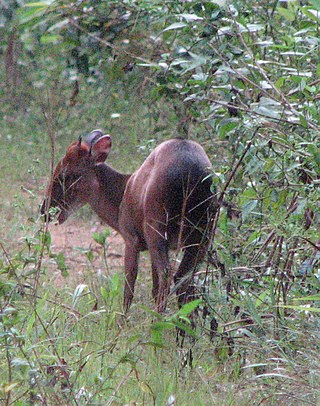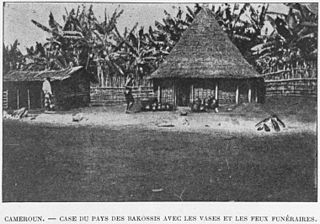
The Bayankhongor Province or Bayanhongor Aimag is one of the 21 aimags (provinces) of Mongolia. It is located in the southwest of the country and, at 116,000 square kilometers, it is one of the largest aimags. The capital of the aimag shares the provincial name, Bayankhongor.

Icém is a municipality in the northern part of the state of São Paulo in Brazil. The population is 8,304 in an area of 362.59 km². It is part of the Microregion of São José do Rio Preto. It is also known as Princesa do Vale, or "Princess of the Valley." Icem is situated near the important urban centers of São José do Rio Preto, Olímpia, Catanduva, and Mirassol. The Marimbondo Dam, which forms a big reservoir in the Rio Grande, is situated close to Icém.
Articles related to Cameroon include:

Kumba is a metropolitan city in the Meme department, Southwest Region, Western Cameroon, commonly referred to as "K-town" colloquially. Kumba is the largest and most developed city in the Meme Department and is increasingly drawing in residents from the local villages such as Mbonge. Kumba has an estimated population of about 400,000 with three quarters of this population being young due to advancement in medicine and lowering infant mortality. The N8 and N16 highways meet at Kumba.
La Gran Sabana is a region in southeastern Venezuela, part of the Guianan savanna ecoregion.
The Manenguba languages, also known as the Mbo cluster, are a group of closely related Bantu languages spoken on and around the Manenguba mountain range in south-western Cameroon.

The Cameroonian Highlands forests, also known as the Cameroon Highlands forests, are a montane tropical moist broadleaf forest ecoregion located on the range of mountains that runs inland from the Gulf of Guinea and forms the border between Cameroon and Nigeria. This is an area of forest and grassland which has become more populous as land is cleared for agriculture.

The wildlife of Cameroon is composed of its flora and fauna. Bordering Nigeria, it is considered one of the wettest parts of Africa and records Africa's second highest concentration of biodiversity. To preserve its wildlife, Cameroon has more than 20 protected reserves comprising national parks, zoos, forest reserves and sanctuaries. The protected areas were first created in the northern region under the colonial administration in 1932; the first two reserves established were Mozogo Gokoro Reserve and the Bénoué Reserve, which was followed by the Waza Reserve on 24 March 1934. The coverage of reserves was initially about 4 percent of the country's area, rising to 12 percent; the administration proposes to cover 30 percent of the land area.
Hyperolius dintelmanni is a species of frogs in the family Hyperoliidae. It is endemic to Cameroon and found in the montane southwestern part of the country. Specifically, it has been recorded from the Bakossi Mountains, including the Edib Hills and Mount Kupe. The specific name, dintelmanni, honors Mr. Horst Dintelmann from Germany in recognition of "his support of taxonomic research and forthcoming conservation projects in Cameroon".
Bankim, M'Bankim,Bamkin or Kimi is a town and commune of the division Mayo-Banyo in Adamaoua in Cameroon. It is about 95 km from Foumban and 125 km from Banyo The area's vegetation is of shrub savanna type.

Campo Ma'an National Park is a 2,680 square kilometer National Park in Cameroon, located in the South Region in the Océan division. It borders with Equatorial Guinea on the south, the Atlantic Ocean to its west, the Vallée-du-Ntem and the Mvila to the east. Total area of the park and buffer zone measure approximately 700, 000 hectares. The climate has two dry seasons, November to March and July to August, and two rainy seasons, April to June and August to October. Average temperature is 25°C.
Tombel is a town and commune in the Southwest Region of Cameroon, in the north of the Mungo Valley. The town is traditionally part of the Bakossi people's country, but now has a significant population of other tribes from other regions of Cameroon.
Capurganá is a town of the municipality of Acandí on the northwestern coast of the Gulf of Urabá in the Colombian department of Chocó, adjacent to the border between Colombia and Panama. Previously a base site for eco-tourists, since 2010 the town's main source of income has been migrants preparing to hike into Panama, across the Darién Gap. In 2019 it was described as a "smugglers' town".

Lake Oku is a crater lake on the Bamenda Plateau in the Northwest Region of Cameroon. It is located at 2,227 metres (7,306 ft) on Mount Oku, and is completely surrounded by cloud forest.

The Bakossi people are a Bantu ethnic group that live on the western and eastern slopes of Mount Mwanenguba and Mount Kupe in the Bakossi Mountains of Cameroon. They number about 200,000, mostly engaged in subsistence farming but also producing some coffee and cocoa.

The Rumpi Hills are an undulating mountain range with its highest peak, Mount Rata about 1,800 m (5,900 ft) located between the villages of Dikome Balue and Mofako Balue, Ndian division in the Southwest region of Cameroon. The hills are situated at 4°50’N 9°07’E, cutting across four local councils, with the eastern slopes in Dikome Balue, southern slopes in Ekondo Titi, western slopes in Mundemba, and northern slopes in Toko local councils respectively. These hills are located about 80 km (50 mi) north of Mount Cameroon; about 50 km (31 mi) west of the Bakossi Mountains and some 15 km (9.3 mi) southeast of the Korup National Park.

The Bakossi Forest Reserve is a 5,517 square kilometres (2,130 sq mi) reserve within the Bakossi Mountains in Cameroon, home to many rare species of plants, animals and birds. The Forest Reserve in turn contains the Bakossi National Park, created by a decree in early 2008. The park covers 29,320 hectares, and was justified on the basis of preserving plant diversification.
The Bakossi National Park (BNP) is a protected area within the Bakossi Forest Reserve, created by a decree in early 2008. The park covers 29,320 hectares, and was justified on the basis of preserving plant diversification.
Chief Epuli Aloh Mathias is Paramount Chief of the Bakossis in the south-west region of Cameroon. His jurisdiction covers all the thirteen Bassossi villages. In addition, he is a judge in the Supreme Court of the Republic of Cameroon. As of 7 June 2017, the Higher Judicial Council headed by president Paul Biya nominated Chief Justice Epuli Aloh Mathias to preside the Judicial Bench of the Supreme Court of Cameroon. After graduating from the National School of Administration and Magistracy (ENAM), he steadily rose through the ranks of the judiciary, working in many jurisdictions in the country. Furthermore, he has worked in helping develop key legislature, providing an insight into the customs and traditions of legal practice and how they were harmonized with local laws in the former West Cameroon under British rule.

Tourism accounts for a large part of El Salvador's economy. El Salvador has many natural attractions including beaches with some of the best surfing breaks on the Pacific Coast. El Salvador offers many lush forests shrouded in cool temperatures with abundant wildlife and scenic mountain-top vistas. El Salvador also has great potential in the field of cultural tourism; with over 2,000 known archaeological sites, mostly of the Maya and Olmec cultures. These sites are of international interest for their easy access and well preserved remains.










